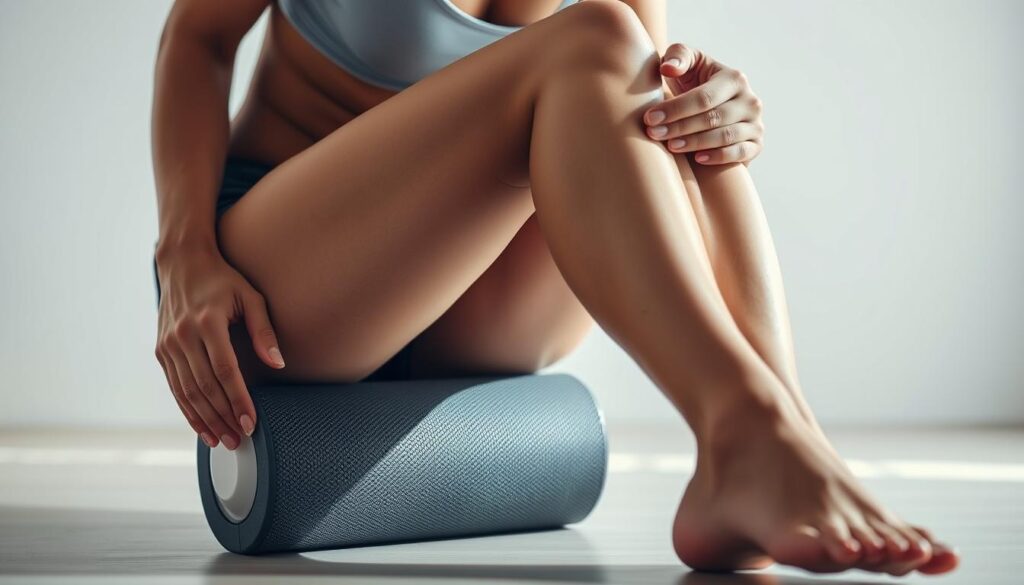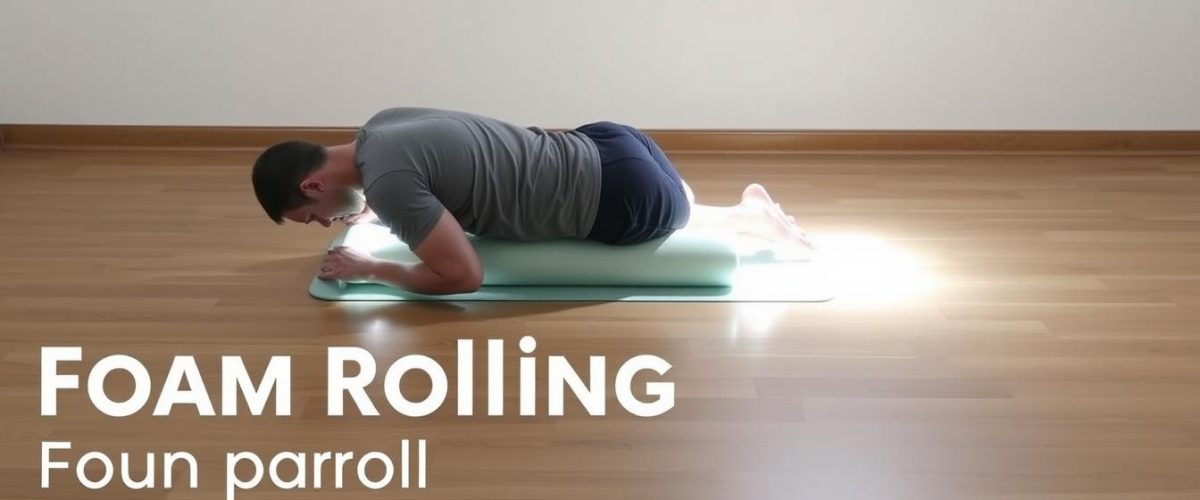Do you often feel stiff and sore after working out or a long day? You’re not alone. Many people deal with muscle tension and less flexibility, making simple tasks hard. Self-myofascial release therapy can really help.
Releasing trigger points in your muscles can ease tension and boost flexibility. A simple tool, like a cylindrical one, can help release muscle tension.
Adding this technique to your daily routine can improve your flexibility and reduce muscle soreness. As a beginner, it’s key to learn the basics and start with a full-body approach with foam rolling routine for beginners.
What is foam rolling routine for beginners?
Foam rolling is a self-myofascial release technique that’s popular among athletes and fitness fans. It uses a foam roller to apply pressure to certain body areas. This helps with muscle recovery and relaxation.
A Brief Overview of Foam Rolling
Foam rolling breaks up muscle, tendon, and ligament adhesions. This process, called myofascial release, improves circulation and lessens muscle soreness. It applies gentle, sustained pressure to release muscle tension and boost overall muscle health.
Benefits for Muscle Recovery
Foam rolling is great for muscle recovery. After working out, muscles often feel sore and inflamed. Foam rolling helps by boosting blood flow to sore areas. This brings oxygen and nutrients to the muscles, aiding in repair.
It also reduces delayed onset muscle soreness (DOMS). DOMS is muscle stiffness and pain after exercise. Adding foam rolling to your routine can lessen DOMS, helping you get back to workouts faster.
Enhancing Flexibility and Mobility
foam rolling routine
Foam rolling also enhances flexibility and mobility. It releases muscle and connective tissue tension. This improves your range of motion and lets you move more easily. It’s especially good for athletes and those who are active regularly.
| Benefits | Description |
|---|---|
| Muscle Recovery | Aids in reducing muscle soreness and inflammation after exercise |
| Flexibility and Mobility | Improves range of motion and reduces muscle tension |
| Circulation | Promotes blood flow to affected areas, delivering oxygen and nutrients |
Choosing the Right foam rolling routine
foam rolling routine
To get the most out of foam rolling, it’s essential to choose a foam roller that suits your needs. With numerous options available, understanding the different characteristics of foam rollers can help you make an informed decision.
Types of Foam Rollers Available
Foam rollers come in various types, each designed for specific purposes. The most common types include:
- Standard Foam Rollers: These are the most basic type, usually made of dense foam. They are great for beginners.
- Textured Foam Rollers: Featuring bumps, ridges, or other textures, these rollers are designed to target deeper tissue areas.
- Vibrating Foam Rollers: Equipped with vibration technology, these rollers can enhance the foam rolling experience by providing additional muscle relaxation.
For beginners, a standard foam roller is often recommended as it provides a good introduction to foam rolling without being too intense.
Firmness and Size Considerations
The firmness and size of a foam roller are critical factors to consider. Firmness affects how deeply the roller can penetrate your muscles. Softer rollers are gentler and more suitable for beginners or sensitive areas, while firmer rollers provide a deeper massage.
When it comes to size, longer rollers are ideal for rolling larger areas like the back and thighs, while shorter rollers offer more control and are easier to maneuver for smaller areas.
As a beginner, starting with a softer foam roller and gradually moving to more textured or firmer ones as you become more comfortable with the technique is advisable.
By considering these factors, you can select a foam roller that meets your specific needs and enhances your foam rolling routine.
Getting Started: Essential Safety Tips
To get the most out of foam rolling, it’s key to follow some safety tips. Foam rolling helps with muscle recovery and boosts flexibility. But, it must be done right.
Listen to Your Body
One of the most important tips is to listen to your body. If you feel too much pain or discomfort, stop. Foam rolling should not hurt, but you might feel some discomfort in areas with scar tissue or knots.
Pay attention to your body’s signals to avoid injuries. If you’re new, start with light pressure and slowly increase it as you get used to it.
Avoiding Common Mistakes
Avoiding common mistakes is crucial for safe foam rolling. One mistake is rolling over bones or joints, which can hurt. Instead, focus on rolling the muscle tissue.
Another mistake is using too much pressure. It’s better to use your body weight to control the pressure. This makes it safer and more effective.
- Start slowly and gently.
- Be aware of your body’s position and alignment.
- Avoid rolling over bony prominences or joints.
- Use your body weight to adjust pressure.
By following these safety tips and listening to your body, you can enjoy foam rolling’s benefits. Remember, the goal is to help with recovery and improve flexibility, not to cause pain or discomfort.
Basic Foam Rolling Techniques
foam rolling routine
Effective foam rolling is more than just rolling. It’s about using the right techniques to target specific muscles. To get the most out of foam rolling, you need to know how to use it right.
General Guidelines for Rolling
When you start with foam rolling, begin slowly. Start with gentle pressure and then increase as you get used to it. Roll the foam roller over the muscle group you want to target, pausing on tight spots. This helps loosen knots and boosts blood flow.
Proper body positioning is key. Make sure you’re aligned right to effectively target the muscle group you want. For example, when rolling your legs, keep your core tight for stability.
Targeting Specific Muscle Groups
Different muscles need different approaches. Here’s how to target some key areas:
| Muscle Group | Technique | Tips |
|---|---|---|
| Hamstrings | Roll from the knee to the glutes | Keep your legs straight and relaxed |
| Quadriceps | Roll from the hip to the knee | Support your body with your forearms |
| Calves | Roll from the ankle to the knee | Cross one leg over the other for deeper pressure |
The secret to good foam rolling is being consistent and patient. By adding these basic techniques to your routine, you’ll see better muscle recovery and flexibility.
foam rolling routine for the Lower Body
The lower body, including the quads, hamstrings, calves, and shins, benefits a lot from foam rolling. It helps ease tension, boosts flexibility, and cuts down muscle soreness in these key areas.
Rolling Your Quads
To foam roll your quads, place the roller under your thighs, just above the knee. Roll slowly up towards your hip, using moderate pressure. Pay attention to the front and sides of your thighs, stopping on any sore spots to release tension.
Tip: Keep your body straight from head to heels, using your core for balance.
Focusing on Hamstrings
For your hamstrings, sit on the foam roller with it just above the back of your knee. Roll up towards your glutes, applying pressure as needed. Adjust the pressure by changing your body weight.
Remember: To effectively target your hamstrings, keep your knees slightly bent and your weight evenly spread.
Relieving Calves and Shins
To roll your calves, sit on the floor with the foam roller under your calf. Cross one leg over the other to increase pressure. Roll from the ankle up towards the knee, focusing on releasing tension in the muscle.
For the shins, use a gentler approach, rolling the front of your lower leg to alleviate tension and improve mobility.
| Muscle Group | Starting Position | Rolling Direction | Tips |
|---|---|---|---|
| Quads | Roller under thighs, above knee | Up towards hip | Keep body straight, engage core |
| Hamstrings | Sit on roller, above knee | Up towards glutes | Keep knees slightly bent |
| Calves | Sit on floor, roller under calf | From ankle to knee | Cross one leg over for more pressure |
| Shins | Sit on floor, roller under shin | Gentle roll, front of lower leg | Use gentle pressure |
foam rolling routine for the Upper Body
foam rolling routine
Upper body foam rolling boosts flexibility and cuts down on discomfort. It targets your back, shoulders, and neck. This helps improve your posture and eases muscle tension.

foam rolling routine
Loosening Up Your Back
Foam rolling your back eases muscle tension along your spine. This improves your posture and lessens strain. To do it right, lie on the roller with it across your spine.
Start slow and gentle, especially if you’re new to foam rolling. As you get more comfortable, you can apply more pressure to reach deeper tissues.
Relaxing Your Shoulders
Shoulder tension is common, especially for desk or computer users. Foam rolling can relax these muscles. It improves your range of motion and cuts down on discomfort.
To foam roll your shoulders, put the roller under your shoulder blade. Roll slowly, focusing on tight spots. You can adjust your position to hit different shoulder muscles.
Easing Tension in the Neck
The neck often gets tense due to poor posture or stress. Foam rolling can ease this tension. It promotes relaxation and reduces pain.
To foam roll your neck, gently place the roller under your neck. Roll slowly, being careful not to apply too much pressure. Rolling the sides of your neck also helps release tension.
Incorporating Foam Rolling into Your Routine
foam rolling routine
Adding foam rolling to your workout routine is key to getting the most out of it. It’s great for athletes and beginners alike. It helps with recovery, boosts flexibility, and eases muscle soreness.
Ideal Frequency and Duration
How often and how long you foam roll depends on your goals and fitness level. Starting with 2-3 times a week is a good rule for general upkeep. If you’re really active, you might need to foam roll more.
A typical session lasts 10 to 20 minutes. You should focus on different muscles each time. Pay attention to how your body feels and adjust as needed.
| Activity Level | Recommended Frequency | Session Duration |
|---|---|---|
| Low | 1-2 times a week | 10 minutes |
| Moderate | 2-3 times a week | 15 minutes |
| High | 3-4 times a week | 20 minutes |
Timing: Before or After Workouts?
When to foam roll depends on your goals and what feels right. It’s good both before and after working out.
- Before Workouts: Rolling before can boost blood flow and performance. It might also lower injury risk.
- After Workouts: Rolling after helps with recovery, eases soreness, and improves flexibility.
Some people also foam roll on rest days. Try different times to see what’s best for you.
Sample Full Body foam rolling routine
foam rolling routine
For beginners, starting a full-body foam rolling routine is key. It helps with muscle recovery, flexibility, and better physical performance.
Step-by-Step Guide for Beginners
foam rolling routine
First, get a foam roller. Roll over your major muscle groups, focusing on tight or sore spots. Begin with your IT band and quads, as they often get tight.
Slowly move the foam roller, pausing a few seconds on tender spots.
Then, focus on your hamstrings and calves. These areas get strained, especially after working out. Spend 1-2 minutes on each leg.
Duration for Each Muscle Group
This routine takes 10-15 minutes to complete. Here’s how to split your time:
- IT band and quads: 2-3 minutes per leg
- Hamstrings and calves: 1-2 minutes per leg
- Back and shoulders: 2-3 minutes
- Neck and arms: 1-2 minutes
Adjust the time based on your comfort and the areas needing most attention. Aim to do this routine daily or after workouts.
Listening to Your Body: Adjusting Techniques
foam rolling routine
When you start using a foam roller, it’s key to listen to your body. You need to know how your body reacts to different pressures and techniques.
Recognizing Pain vs. Discomfort
foam rolling routine
It’s important to tell the difference between pain and discomfort when foam rolling. Discomfort is normal, especially when you’re working on areas with scar tissue or adhesions. But sharp pain means you’re applying too much pressure or hitting a sensitive spot.
To stay safe, listen to your body’s signals. If you feel pain, stop right away and change how you’re doing it. Start with light pressure and slowly increase it as you get used to it.
| Sensation | Possible Cause | Action |
|---|---|---|
| Mild Discomfort | Normal response to foam rolling | Continue with gentle pressure |
| Sharp Pain | Too much pressure or sensitive area | Reduce pressure or avoid area |
| Numbness or Tingling | Pressure on nerves | Adjust position to relieve pressure |
Modifying Techniques as Needed
As you get better at foam rolling, you might need to change your methods. If some areas feel too sensitive, try modifying your pressure or changing the angle of your roll.
For instance, if your IT band is sore, rolling your quadriceps or hamstrings first can help loosen the area.

foam rolling routine
By listening to your body and adjusting your foam rolling techniques, you can get the most out of it. This way, you can enjoy its benefits without worrying about getting hurt.
Foam Rolling and Active Recovery
Active recovery is crucial for any workout routine. Foam rolling helps improve blood flow and reduce muscle tension. It makes your body heal faster and get ready for more workouts.
Importance of Active Recovery
Active recovery keeps you at your best. It includes light activities like cardio or stretching. These help move blood and clear waste from your muscles. Foam rolling is great for reducing muscle soreness and boosting circulation.
Adding foam rolling to your recovery routine offers many benefits. You’ll see better flexibility, less muscle tension, and faster recovery.
Combining Stretching with Foam Rolling
Stretching with foam rolling boosts recovery even more. Foam rolling loosens muscles, making stretching more effective. This combo is perfect for athletes and anyone wanting to improve their performance.
Focus on stretching your hamstrings, quadriceps, and hip flexors. This will improve your flexibility and reduce soreness. It helps you recover better overall.
FAQs About foam rolling routine
You might have questions about foam rolling, especially if you’re new to it. Foam rolling can seem scary or confusing at first. But knowing the basics can make your experience better and help you use this technique well.
How Often Should I Foam Roll?
Foam rolling can be done every day, but listen to your body. Start with a few times a week if you’re new. Then, you can do it more often as you get used to it.
Key considerations for frequency include:
- Your current fitness level and goals
- The intensity of your workouts
- Any areas of tension or pain you’re targeting
Can Foam Rolling Hurt?
Foam rolling might feel uncomfortable, especially if you’re targeting scar tissue or knots. But it shouldn’t hurt. If you feel pain, you might need to change how you’re doing it or talk to a healthcare professional.
Tips to avoid pain while foam rolling:
- Start with gentle pressure and gradually increase as needed
- Avoid rolling directly on bony prominences or joints
- Use slow, controlled movements
What If I Don’t Have a foam rolling routine?
If you don’t have a foam roller, you can use other things like a tennis ball or a lacrosse ball. These are good for smaller areas like the IT band or muscles around the shoulder blade.
- Using your own body weight and positioning to apply pressure
- Seeking out self-myofascial release techniques that don’t require equipment
- Considering other tools like rolling pins or massage sticks
Additional Resources for foam rolling routine
To improve your foam rolling, check out online resources like videos and tutorials. These guides show you how to target muscles and boost flexibility and mobility. They’re great for learning new techniques.
Recommended Videos and Tutorials
YouTube and fitness platforms have many videos on foam rolling. Fitness experts share their top exercises and routines. These can help you make the most of your foam rolling.
Books and Articles on Foam Rolling Techniques
Books and articles offer a deeper look into foam rolling benefits and techniques. They help you understand how to use foam rolling in your fitness routine. This can improve your recovery and performance.


